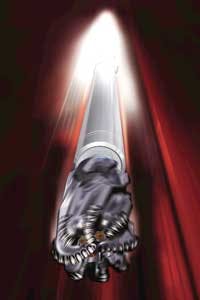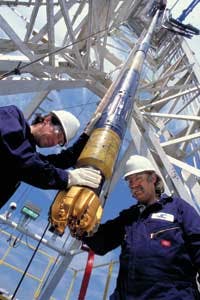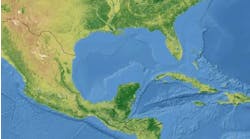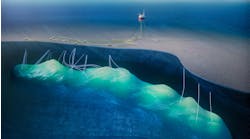Offshore has completed its annual survey of the latest rotary steerable systems available on the market today, and the results show that the offshore drilling industry has made a number of advances in the field.
APS, Baker Hughes, Gyrodata, Halliburton, Schlumberger, and Weatherford have been in the forefront of rotary steerable technology in the last several years. Their advances in RSS drilling technology have led to lower costs and greater productivity for their customers.
Read about Halliburton and Baker Hughes' success below and check out the updated RSS directory on the following pages.
Putting RSS to the test
Devon Energy recently approached Halliburton for help in reducing operational time while drilling an extended reach directional well from a platform in the Polvo field, offshore Brazil.
Halliburton suggested using its Geo-Pilot XL 7600 series rotary steerable system to reduce trips for bottomhole assemblies (BHA) and to increase rate of penetration (ROP). Halliburton deployed the Geo-Pilot XL 7600 with an 8½-in. FMF3565Z Geo-Pilot bit, as well as pressure-while-drilling (PWD) and downhole vibration sensors. Halliburton also used its ADT applied drilling technology drilling optimization service to continuously monitor drilling parameters and damaging vibration.
According to Halliburton, Devon Energy saved three days of rig time, an estimated $1,050,000.
Devon Energy and Halliburton have made numerous improvements to drilling practices and tool selection over the past two years and increased tool reliability in this offshore directional application.
This well plan called for drilling at a tangent angle of 72° to a maximum vertical section distance of approximately 5,800 m (19,029 ft), which made hole cleaning a challenge and required care to ensure the wellbore was in optimal condition for tripping out, Halliburton said.
The service company used high-flow tools combined with the Geo-Span downlink system, which helped increase BHA life and resulted in higher instantaneous ROP.
Halliburton ran its Geo-Pilot system with a matched extended-gauge bit design to help eliminate hole spiraling and minimize wellbore tortuosity while maximizing ROP and directional control. Due to the extended reach of the well, it also was critical that Halliburton accurately monitor equivalent circulating density (ECD), so the service company ran a PWD sensor along with downhole vibration sensors.
Halliburton's matched drilling solution delivered a record 4,080 m (13,386 ft) in a single run, surpassing the previous registered record length of 2,471 m (8,107 ft), on the way to the target depth of 5,564 m (18,255 ft), the service company said. Halliburton also set a new record for most meterage for 24 hours, drilling 1,610 m (5,282 ft) during that time.
In addition, Halliburton said the run achieved a penetration rate of 96.9 m/hr (318 ft/hr) – more than four times faster than the next-best offset ROP of 23.10m/hr (76 ft/hr).
At the record ROP of 1,610 m in 24 hours, the service company said the faster drilling resulted in better hole condition in general, and therefore less time lost on trips, as well as better gauge hole and significant reduction in mud consumption.
What's more, Halliburton said the capability to rapidly and accurately drill very extended reach wells from the platform has made a much larger area available to be drilled, and may avoid the need for Devon to bring in a semisubmersible rig to drill and complete this type of well.
Baker launches AutoTrak Curve RSS
Drilling in tight leases is challenging for operators, who now can look to Baker Hughes' AutoTrak Curve RSS, which can drill vertical, curve and horizontal sections in one run to maximize available pay zones and reduce the number of trips.
"This is a rotary steerable system that drills what used to take two to three trips in one smooth run," said Art Soucy, Baker Hughes' president of global products and services. "The AutoTrak Curve system drills more precisely and at a much tighter angle than any other similar service. The tight angle is particularly critical as it enables our customers to intersect a much larger area of the reservoir than was previously possible with rotary steerable systems, resulting in 750 plus feet of additional pay zone."
According to Baker Hughes, the AutoTrak Curve rotary steerable is a closed-loop drilling system that takes commands from the surface to place the wellbore in the desired direction and inclination.
Combining an optimized bottomhole assembly and drill bit to maximize drilling efficiency and reservoir exposure, the AutoTrak Curve system achieves high build rates of more than 15°/100 ft, Baker Hughes said.
Tolerant to the presence of lost circulation material in the mud system, the AutoTrak Curve system does not require special pressure drop between the pipe inside diameter and the annulus to operate. Additionally, a gamma ray detector is integrated into the tool, close to the bit, to allow precise geosteering.
The advanced technology saves time, according to the company, given there is no need to change the bend angle of a motor, resulting in faster well construction.
Given the improved hole quality, completion time also is enhanced and casing can be run to total depth faster and easier.
For instance, an operator in the Eagle Ford had drilled the vertical, curve and horizontal sections in three different trips. The challenge: do it in one trip.
Using the AutoTrak Curve system, an optimized Baker Hughes PDC bit and Baker Hughes' Carbo-Drill oil-based fluids, the entire 8¾-in. section was drilled in one fast run, saving two unnecessary trips.
A total of 9,735 ft in 83 drilling hours was achieved. Optimal placement of the well on plan delivered better production faster. The solution saved the operator two days.
Offshore Articles Archives
View Oil and Gas Articles on PennEnergy.com





